
|
Super-Heroes Other Super-Heroes |
(chronological by time period and film title) Introduction | Flash Gordon | Buck Rogers | Superman | Batman | Spider-Man | X-Men Marvel Cinematic Universe | The DC Extended Universe Iron Man | Hulk | Thor | Captain America | The Avengers | Guardians of the Galaxy Others: A - F | Others: G - N | Others: O - Z |
Other Super Heroes and/or Comic-Book Adaptations/Characters (chronological by time period and film title) |
|||||||||||||||||
The Phantom - was based on the comic strip The Phantom created by Lee Falk that first appeared as a daily, syndicated (King Features) newspaper strip on February 17, 1936. The series made its US debut in the Hearst-owned New York Journal-American newspaper. The first comic strip episode was titled, "The Singh Brotherhood." The initial episodes were written and drawn by Falk himself. "The Singh Brotherhood," the first-ever Phantom comic strip, ran until November 7, 1936, a total of 38 weeks. It was notable as the first newspaper strip that introduced the idea of a masked crime-fighter (or superhero) to a wide audience.
The Phantom was the first costumed, masked superhero. Originally, the Phantom was the secret identity of a rich playboy named Jimmy Wells, who was the childhood friend of Diana Palmer, his future girlfriend/fiancee. In later stories, the Phantom was moved to the jungle in the African nation of Bengalla, and took the name Kit Walker. In the comic strip, the Phantom's real name was Kit Walker, while in the 1943 theatrical serial, his name was Geoffrey Prescott. A color strip for Sunday was added on May 28, 1939. The Phantom (literally "The Ghost Who Walks") wore a trademark violet-colored (purple) skin-tight costume, and thin black eye-mask (showing whited-out eyes without visible pupils).
|
|||||||||||||||||
| Super-Hero Films | |||||||||||||||||
|
The Phantom (1943) - Theatrical Serial Columbia Pictures' low-budget 15-chapter cliffhanger serial (240 minutes in length) starred silent screen cowboy Tom Tyler in the title role (aka The Ghost Who Walks) and as alter-ego Geoffrey Prescott. The Phantom was joined by his girlfriend/fiancee Diana Palmer (Jeanne Bates) and a German shepherd named Devil ('Ace' the Wonder Dog). The Phantom battled in "Darkest Africa" against criminals (led by Dr. Max Bremmer (Kenneth MacDonald)), during a search for the Lost City of Zoloz.
There was an attempt to make a 15-chapter sequel-serial by Columbia Pictures, which due to rights restrictions, had to be retitled The Adventures of Captain Africa (1955), with John Hart in the lead role as the masked government agent, Captain Africa. It contained lots of repetitive and stock footage. |

|
|||||||||||||||
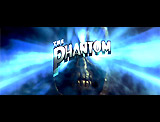
|
The Phantom (1996) Director Simon Wincer's film starred Billy Zane as the 'Phantom' crimefighter, and Kristy Swanson as Diana Palmer. Catherine Zeta-Jones appeared as Sala, the leader of an all-female gang of air pirates known as the Sky Band, and Treat Williams portrayed the villain Xander Drax. The Phantom's main objective was to stop Drax from obtaining a weapon of doom - the legendary "Skulls of Touganda." The Paramount film was a box-office failure, curtailing plans for further sequels. |

|
|||||||||||||||
Popeye - was based on E.C. Segar's comic strip of the same name, created in 1929. Popeye (the Sailor Man) first appeared as a minor character in the daily (King Features) comic strip, titled "Thimble Theater" on January 17, 1929. The Thimble Theater strip was in its 9th year at the time. In this first strip, Popeye's love interest was Olive Oyl, although her boyfriend was Harold Hamgravy. Olive's loopy brother Castor Oyl knew nothing about sailing. At the waterfront, he was looking to hire a sailor, and walked up to a pipe-smoking man with a captain's hat (and pipe) and asked: "Are you a sailor?" Popeye replied: "Ja think I'm a cowboy?" And he was promptly hired. The popular new character was soon given a larger role. Only later would spinach play a significant role, as would Bluto. There were many name changes for the strip -- a spin-off strip was established in the 1950s titled Popeye the Sailorman. And the Thimble Theater strip was re-titled Thimble Theatre Starring Popeye, and eventually retitled as just Popeye.
|
|||||||||||||||||
| Super-Hero Films | |||||||||||||||||
 Fleischer Studios (1933-1942)  Betty Boop's Popeye The Sailor (1933)   I Yam What I Yam (1933)   Popeye Color Feature (1936)  Famous Studios (1942-1957) |
Popeye the Sailor (1933-1957) - Theatrical Animated Cartoons In 1933, Max and Dave Fleischer's Fleischer Studios adapted the Thimble Theatre characters into a series of Popeye the Sailor theatrical cartoon shorts (108 in number) for Paramount Pictures, through 1942. Production was continued through 1957 by Paramount's own Famous Studios, with 122 more cartoons. Together, the cartoons and newspaper comic strips launched a huge Popeye fad. And less than a decade after the first Popeye cartoon, the quintessential comic book superhero Superman would become another major success for Fleischer Studios in 1941. Popeye first debuted in a Betty Boop cartoon titled Popeye the Sailor, released on July 14, 1933. It was Betty Boop cartoon # 14. I Yam What I Yam was the first official Popeye cartoon (black and white) in the series produced by the Fleischer Studios between 1933 and 1942. The 7-minute cartoon was theatrically aired on September 29, 1933. In the short, Bluto sang the opening title song, "Strike The Band For Popeye The Sailor," reused from Popeye The Sailor (1933). This cartoon also featured the debut appearance of J. Wellington Wimpy, as well as the first usage of the opening/closing ship doors in the main titles. There were also 3 two-reel, animated cartoon short subjects featuring Popeye, in the Popeye Color Feature series by Paramount Pictures in 1936, produced in Technicolor:
|
 Popeye the Sailor Meets Sindbad the Sailor (1936)  Popeye the Sailor Meets Ali Baba's Forty Thieves (1937) 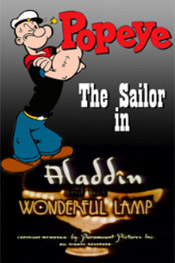 Aladdin and His Wonderful Lamp (1939) |
|||||||||||||||

|
Popeye the Sailor (1960-1962) - Animated TV series TV reruns of the Fleischer/Famous Studios theatrical shorts (see above) proving that Popeye could deliver smash ratings. In 1960, King Features Syndicate (under the aegis of executive producer Al Brodax) produced a new series of short made-for-TV cartoons entitled Popeye The Sailor - for TV syndication on ABC - a total of 220 cartoons were produced in two years. The series was produced by several different animation production studios or companies:
This new TV version of the adventures of Popeye the Sailor featured the voices of Jack Mercer (as Popeye), Mae Questel (as Olive) and Jackson Beck (as Brutus, the new name for Bluto). The series had limited animation techniques, but enhanced the storylines. The syndicated series of cartoons aired continuously into the 1990s. |
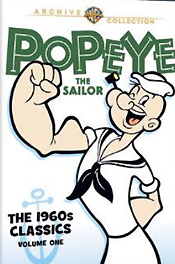
|
|||||||||||||||

|
Popeye (1980) Director Robert Altman's box-office failing musical starred Robin Williams as the squinty-eyed, pipe-smoking sailor title character with muscular arms, and Shelley Duvall as stick-thin Olive Oyl. |

|
|||||||||||||||
Power Man - (aka Carl Lucas, or Luke Cage) - Marvel's contribution to the blaxploitation series of 1970s films was this black superhero. He first appeared in the comics in Luke Cage, Hero For Hire # 1 (June 1972). He started out as a wrongly-imprisoned convict (framed for cocaine possession), who had attained superhuman strength and unbreakable, bullet-proof skin after being the subject of an dubious scientific experiment at the Seagate Prison, when a racist guard tampered with the machine. After his release, he teamed up with another superhero, an old friend known as Iron Fist, contracting themselves out as "Heroes for Hire." He was associated with another superpowered female, his wife Jessica Jones.
|
|||||||||||||||||
| Super-Hero Films | |||||||||||||||||

|
Jessica Jones (aka Marvel's Jessica Jones) (2015-2016) - Netflix limited TV series Ex superhero and private investigator Jessica Jones (Krysten Ritter), suffering from PTSD, operated her PI agency's business in the Hell's Kitchen area of New York City. Mike Colter co-starred as Luke Cage. |

|
|||||||||||||||
The Punisher - was an action-based comic-book superhero film, based on a Marvel Comics anti-hero character created by Gerry Conway (with publisher Stan Lee) that first appeared in The Amazing Spider-Man # 129 (February 1974). His origin story was contained in a few different issues: Marvel Preview # 2 (August 1975) (in "Death Sentence"), and Marvel Super Action # 1 (January 1976) (in "Accounts Settled...Accounts Due!"). The superhero character was revived and received his own comic-book issue in 1994 -- Punisher: Year One # 1-4 (December 1994 to March 1995). In the comics, the Punisher (aka Frank Castle (born Castiglione)) wore an iconic black T-shirt with a large skull printed on it. A 4-year Vietnam War veteran, Frank Castle became a vigilante and organized crime-fighter after seeing his wife and children gunned down for accidentally observing a Mafia "hit."
|
|||||||||||||||||
| Super-Hero Films | |||||||||||||||||
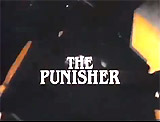
|
The Punisher (1989, Australia/US) The first film was a straight-to-video release by director Mark Goldblatt, starring Dolph Lundgren as the gritty anti-hero Frank Castle. It was never released theatrically in the US. |

|
|||||||||||||||

|
The Punisher (2004) Director Jonathan Hensleigh's rebooted film featured The Punisher/aka Frank Castle (Tom Jane) - a frontier-style, ruthless and vengeful vigilante in modern-day urban America. It was first comic book adaptation since Blade (1998) to earn an R rating. |

|
|||||||||||||||

|
Punisher: War Zone (2008) (aka The Punisher 2) This reboot and sequel starred Ray Stevenson in the lead role. It had the tagline: "Vengeance Has a Name." It was one of the lowest-grossing Marvel films of all time. After this film, the live action film rights to The Punisher reverted back to Marvel Studios. |

|
|||||||||||||||
The Rocketeer - was based upon the comic-book character created by writer/artist Dave Stevens in 1982. The Rocketeer first appeared in a cameo in Starslayer # 1 (February 1982), and then more fully in Starslayer # 2 (April 1982).
|
|||||||||||||||||
| Super-Hero Films | |||||||||||||||||

|
The Rocketeer (1991) Director Joe Johnston's and Disney's film was based on the 1980s comic-book character. It told about a top-secret rocket-jetpack (sought by Nazi spies) that propelled a young 1938 Los Angeles stunt flyer (unknown actor Billy Campbell as Cliff Secord) into being a super-hero, opposite Jennifer Connelly as Secord's aspiring actress/girlfriend Jenny Blake. His superpowers attracted the attention of the FBI, rocket-pack-inventor Howard Hughes (Terry O'Quinn), and a Nazi spy-secret agent named Neville Sinclair (Timothy Dalton) (modeled after actor Errol Flynn). The action film was well-received by critics, but bombed at the box-office, and ended hopes for a sequel. |

|
|||||||||||||||
The Shadow - a crime-fighting vigilante, was based upon the Walter B. Gibson character created in the early 1930s. The Shadow made his first appearance on July 31, 1930, as the mysterious narrator of a radio program titled The Detective Story Hour. [Note: The weekly radio program dramatized stories from Street & Smith’s pulp-fiction magazine Detective Story Magazine (1915-1949).] The radio program was narrated by a mysterious character specifically created for the radio show known as The Shadow. The Shadow originally served as each episode's narrator, not its protagonist. He had sinister tones and a ghostly laugh (voice of actor Frank Readick) - as described in Walter Gibson's early Shadow novels. In 1931 and 1932, Universal Pictures created a series of six film shorts based on the popular Detective Story Hour radio program, narrated by The Shadow. Also because of the radio show's popularity, a pulp series detective magazine titled The Shadow - A Detective Magazine from Street & Smith, first appeared on April 1, 1931 on newsstands. It featured The Shadow in his first literary story "The Living Shadow" - created and primarily written by the prolific Walter B. Gibson, who had been hired by the publisher to create a backstory. Author Gibson refashioned the sinister narrator of CBS Radio's The Detective Story Hour into a dark super-hero - a super-sleuth who often battled against super-criminals. Then, in September of 1937, The Shadow radio drama premiered, and the first full-length feature film about The Shadow was released by Grand National Pictures. The Shadow became a major influence on future superheroes, including Batman. Also, the words that introduced The Shadow in the radio program (and the films) have become immortalized: "Who knows what evil lurks in the hearts of men? Only the Shadow knows!"
|
|||||||||||||||||
| Super-Hero Films | |||||||||||||||||

|
The Shadow Strikes (1937) Rod La Rocque starred as The Shadow/Lamont Cranston, a crime-solver, in this hour-long film by Grand National Pictures. It was the first of two films by the studio. |

|
|||||||||||||||

|
International Crime (1938) Rod La Rocque returned as The Shadow/Lamont Cranston - an amateur criminologist and detective, another film from Grand National Pictures. La Rocque co-starred with Astrid Allwyn as Phoebe Lane. |

|
|||||||||||||||
|
The Shadow (1940) - Theatrical Serial Directed by James Horne, this 15-part Columbia Pictures serial was advertised as: "HOT FROM RADIO AND MAGAZINE." The Shadow films were based upon the classic radio series and pulp magazine character. Lamont Cranston/The Shadow (Victor Jory), a wealthy criminologist, battled an industrialist terrorist-villain (elusive and invisible) known as The Black Tiger (voice of Richard Cramer), who threatened the world with a death ray. Cranston’s alter-ego identity was known only to his secretary Margo Lane (Veda Ann Borg), his chauffeur Vincent (Roger Moore), and a Chinatown shopkeeper Wu Yung (Phillip Ahn) - who also aided Cranston in another identity as Chinese fence Ling Chang.
|

|
|||||||||||||||
   |
The Shadow Returns (1946) There were three low-budget, quickie 1946 feature films (each about an hour in length from Monogram Pictures) starring Kane Richmond as Lamont Cranston/The Shadow, and Barbara Reed as Margo Lane. The first B-film was often considered the worst of three 1946 Shadow movies.
|
||||||||||||||||

|
Invisible Avenger (1958) (aka Bourbon Street Shadows) Invisible Avenger was a feature film (60 minutes in length) composed of two segments or episodes of Republic Pictures' TV pilot made in 1957, that starred Richard Deer as Lamont Cranston/The Shadow. The Shadow investigated the murder of a New Orleans jazz bandleader. It was re-released as Bourbon Street Shadows (1962). |

|
|||||||||||||||

|
The Shadow (1994) Director Russell Mulcahy's and Universal's film starred Alec Baldwin (aka Lamont Cranston). It was one of the least successful of the super-hero films, thereby failing to become a franchise. |

|
|||||||||||||||
The Shield - was the first patriotically-themed superhero US character with a star-spangled costume (soon imitated by Marvel's Captain America and others). He first appeared in Pep Comics # 1 (January 1940) (published by MJL Magazines, now Archie Comics), created by writer Harry Shorten and artist Irv Novick. The origin story of the Shield (S.H.I.E.L.D.), about alter-ego chemist Joe Higgins, who had refined a chemical formula for super-strength that was applied to various parts of his body (Sacrum, Heart, Innervation, Eyes, Lungs, Derma), was detailed in Shield-Wizard Comics # 1 (June 1940).
|
|||||||||||||||||
Sin City - was adapted from Frank Miller's Eisner Award-winning comic book series of graphic, dark neo-noir crime stories, beginning in the early 1990s with Sin City. The first episode of Sin City originally appeared in Dark Horse Presents Fifth Anniversary Special (April 1991) - it was part one of 13 parts. The episodic story under the title Sin City was serialized in 13 parts in the comics anthology Dark Horse Presents # 51–62 (June 1991 to June 1992). The 13 separate Sin City stories were reprinted in January 1993, and renamed The Hard Goodbye for the full trade paperback comic-book version.
Three major Sin City stories (the first, fourth, and sixth) were the basis for the movie Sin City (2005): The Hard Goodbye, The Big Fat Kill, and That Yellow Bastard. In addition, the short story "The Customer Is Always Right" (in the third story) was the basis for the opening sequence. The second story in the Sin City series, written and drawn by Frank Miller, was titled A Dame to Kill For. It was first published by Dark Horse Comics (Legend) as six issues from November 1993 to May 1994. It was the first story published in a mini-series format, with six monthly issues. The story became the basis for the sequel film, Sin City: A Dame to Kill For (2014).
|
|||||||||||||||||
| Super-Hero Films | |||||||||||||||||

|
Sin City (2005) Co-directed by Robert Rodriguez and Frank Miller. Shot in stark black and white, with some bursts of color. There were three separate, loosely-related stories, based on Miller's pulpy comic books:
|

|
|||||||||||||||

|
Sin City: A Dame To Kill For (2014) A sequel, based upon the second story, A Dame to Kill For, from Frank Miller's pulpy comics. PI Dwight McCarthy (Josh Brolin) attempted to rescue seductive Ava Lord (Eva Green), his former fiancée, who claimed that her wealthy tycoon husband, Damian Lord (Marton Csokas) and her husband's servant/valet Manute (Dennis Haysbert), were sadistically torturing her. After beating her husband to death, to his horror, Dwight realized that he had been set up by the femme fatale. Ava shot Dwight several times, then taunted and thanked him for helping her murder her husband and acquire his fortune. |

|
|||||||||||||||
Spawn - was the leading anti-hero character that debuted in Image Comics' Spawn # 1 (May 1992), created by Todd McFarlane. The character was born as Albert "Al" Francis Simmons, who served in a special, top-secret covert ops division known as the US Security Group - as a highly-trained assassin. After being murdered on a mission in Botswana, he was sent to Hell. He sold his soul to Malebolgia and became a Hellspawn (one of the Demonic Being's soldiers to do his bidding, with superpowers granted by the Devil) in exchange for being allowed to see his wife Wanda Blake one last time. Spawn/Al had to get used to the idea that widowed Wanda married his best friend Terry Fitzgerald and had a daughter with him named Cyan.
|
|||||||||||||||||
| Super-Hero Films | |||||||||||||||||

|
Spawn (1997) The fantasy adventure/horror film featured the debut of the dark character created by comic book artist (and executive producer) Todd McFarlane - the vengeful, super-powered anti-hero from Hell named Spawn (Michael Jai White), and widowed wife Wanda Blake (Theresa Randle). The film was only a moderate success, and failed to inspire a sequel or franchise. Spawn (1997) was followed by an adult-themed series of animated sequels created in conjunction with HBO - a three-season run of 18 episodes. See below. |

|
|||||||||||||||
| Todd McFarlane's Spawn (1997-1999)
- TV series
The animated TV series which aired on HBO from 1997 through 1999, was based upon the Spawn comics. All three seasons were released separately on home video as three feature-length movies, with all the episodes edited together.
|
|||||||||||||||||
The Spectre - was an early DC Comics' superhero created by Jerry Siegel and Bernard Baily. He first appeared in an ad promoting his appearance (in the next issue) in More Fun Comics # 51 (January 1940). Spectre's first story was in the next month's More Fun Comics # 52 (February 1940). Spectre became a member of the first-ever superhero team, the Justice Society of America. Originally, Spectre was hard-boiled police officer Jim Corrigan who was brutally murdered. He returned to Earth as a ghostly spectre with tremendous, almost unlimited and invulnerable super-powers, ready to avenge Corrigan's death and destroy all evidence of evil. With just his touch, he could transform evildoers into skeletons. So far, Spectre has not had a significant role in TV or film.
|
|||||||||||||||||
The Spirit - was a masked, glove-wearing superhero vigilante crimefighter based on Will Eisner's comic-strip The Spirit. He first appeared on June 2, 1940 in an 8 page section of a 16-page Sunday newspaper supplement (distributed in Register and Tribune syndicated papers), along with two other stories (Lady Luck and Mr. Mystic). This weekly supplement (an unprecedented format - a color comic book in a newspaper!), known as "The Spirit Section," continued until October 5, 1952, with a total of 645 issues. The Spirit's alter-ego was erroneously-deceased Detective Denny Colt who was strangely resurrected after his death when he woke up in Wildwood Cemetery (and henceforth operated from it as a 'hide-out'). The Spirit had a stereotypical African-American assistant named Ebony White. The Spirit was known only to Commissioner Dolan, the police commissioner in Central City, the Spirit's town.
|
|||||||||||||||||
| Super-Hero Films | |||||||||||||||||

|
The Spirit (2008) Writer/director Frank Miller's noirish super-hero film (Miller's first solo directorship) starred Gabriel Macht as Denny Colt (aka the masked crimefighter The Spirit) battling his arch-nemesis The Octopus (Samuel L. Jackson). Scarlett Johansson co-starred as femme fatale Silken Floss. |

|
|||||||||||||||
Steel (originally Man of Steel) (aka Man of Iron) - the armor-clad character, originally known as John Henry Irons, was a spin-off after being introduced in DC Comics' Reign of the Supermen! storyline in The Adventures of Superman # 500 (June 1993) (in the story "First Sighting - The Man of Steel"). Steel, originally a weapons/ballistics engineer named Dr. John Henry Irons, became a superhero in emulation of Superman. He had developed for himself a steel exo-skeleton (a suit of armor), flight boots, an "S-shield" insignia and cape, and advanced weapons including a kinetic-energized hammer. His primary alias was the name Steel. Steel then became a starring character, beginning in Superman: The Man of Steel # 22 (June 1993) (this issue included a fold-out Man of Steel poster).
|
|||||||||||||||||
| Super-Hero Films | |||||||||||||||||

|
Steel (1997) Writer/director Kenneth Johnson's urban-oriented superhero film starred basketball star Shaquille O'Neal as the title character Steel (aka weapons inventor-designer John Henry Irons), who was assisted by wheel-chaired Susan "Sparky" Sparks (Annabeth Gish). He battled villainous weapons dealer Nathaniel Burke (Judd Nelson). The box-office bomb was advertised with the tagline: "Heroes Don't Come Any Bigger," and described Steel as a "Man-Metal-Hero." O'Neal was nominated for a Worst Actor Razzie award. |

|
|||||||||||||||
The Sub-Mariner (aka Namor, the Sub-Mariner) - was a long-running Marvel Comics' mutant superhero (anti-hero) character (and the first Marvel hero, actually he was the first known comic-book anti-hero), originally created by writer-artist Bill Everett to introduce the character in the first pilot issue of the Motion Picture Funnies Weekly # 1 (published by First Funnies, Inc.), dated April 1939. This issue was never officially published, although promotional pamphlet samples were available for distribution by some movie theatres. The Sub-Mariner was one of Marvel's oldest characters. The Sub-Mariner's first story was 8 pages long and in black and white. This first story was reprinted with four additional pages (and in color) - it marked the first official appearance of the Sub-Mariner, in Marvel Comics # 1 (October 1939). He was the first super-hero who was able to fly. [Note: This was the first comic book from Timely Comics, the predecessor of Marvel Comics.] The first cover appearance of the Sub-Mariner was in Marvel Mystery Comics # 4 (February 1940). He met (and battled) with the original Human Torch (the android called Jim Hammond) in a later issue, Marvel Mystery Comics # 8 (June 1940). This made comic-book history - it was the first super-hero meeting and team-up. The Sub-Mariner was one of Timely Comics' top three super-heroes at the time, along with Captain America and the Human Torch. The Sub-Mariner was aka Namor McKenzie, an Atlantean/Human Mutant hybrid from the mythical undersea kingdom of Atlantis. The Sub-Mariner was bred specifically to be "an avenging son" (the offspring of a US sea captain and blue-skinned Atlantis princess Fen) to lead the Atlanteans in "mortal combat" against the "surface men of the world." The Atlantis kingdom had been threatened by "bombardments of high explosives" (to break up ice floes) during various scientific investigations. The Sub-Mariner was revived in 1962 by the newly established Marvel Comics, in Fantastic Four # 4 (May 1962) - the character's first Silver Age of Comics appearance. Prince Namor was given a more noble speaking style. He sought revenge on cruel humans who "invaded our ancient home deep in the waters at the South Pole" and "nearly exterminated" the entire race - now with explosions of atomic bombs. The Sub-Mariner has made a number of brief appearances, mostly in animated TV series, but has not been the subject of a feature film.
|
|||||||||||||||||
Supergirl - a super-powered female named "The Girl of Steel" was DC's female counterpart for Superman. She first made a one-time appearance in DC Comics' Superman # 123 (August 1958), in the story: "The Three Magic Wishes," by writers Otto Binder and Dick Sprang. There were three parts to the story, in which Jimmy Olsen 'wished' a Super-Girl-like individual into existence, with a wish-granting totem.
Because of positive responses to Superman # 123, Supergirl was created and first appeared in Action Comics # 252 (May 1959), with an explanation of her origin or backstory in "The Supergirl From Krypton!" The story was written by Otto Binder, and penciled and inked by Al Plastino.
In the domed city of Argo City on the doomed planet of Krypton, Zor-El (Jor-El's brother and Superman's uncle) and his wife Alura sent their young daughter Kara to Earth in a costume similar to Superman's. He met his related cousin at her crashed rocket, and realized she had similar super-powers. She took the secret identity of Linda Lee, wore a brunette wig, and took up residence in Midvale Orphanage while attending Stanhope College. She was adopted by Fred and Edna Danvers in Action Comics # 279 (August 1961). Later on, she became the "guardian angel" of Midvale, and secretly performed good deeds against crime with her alter ego. Supergirl was publicly revealed in Action Comics # 285 (February 1962) as "The World's Greatest Heroine."
Stories about Supergirl as a lead character continued in Adventure Comics for 44 issues, beginning with Adventure Comics # 381 (June 1969) and ending with Adventure Comics # 424 (October 1972). The October 1972 issue was the last issue of Adventure Comics featuring Supergirl.
The DC Comics' female superhero also appeared in a series of on-going comic-book issues, published in six distinct volumes from 1972 to 2015. In Volumes 1 and 2, Supergirl was featured as Superman's Kryptonian cousin, Kara Zor-El. In Volume 3, the first Modern Age version of Supergirl, she was known as Matrix (an other-dimensional shapeshifter), and in Volume 4, she merged together Matrix and human Linda Danvers (an Earth-born angel). Volume 5 featured the return of the Kryptonite version of Supergirl (Kara Zor-El), while Volume 6 went in a different direction:
|
|||||||||||||||||
| Super-Hero Films | |||||||||||||||||

|
Supergirl (1984, UK) Taglined as "Her First Great Adventure," this was DC Comics-book heroine Supergirl's first feature-length movie, and a spin-off from three popular Superman films at the time. It was directed by Jeannot Szwarc and written by David Odell, and starred Helen Slater (in her debut feature film) in the lead title role as Kara Zor-El (aka Supergirl or Linda Lee). Marc McClure was the only one to reprise his role from the Superman films - appearing as Jimmy Olsen. Unfortunately, the film was critically assailed, and two of the main roles received Golden Razzie Awards nominations for Worst Actor and Worst Actress: Peter O'Toole (as Argo City's mad villain Zaltar) and Faye Dunaway (as evil sorceress Selena). |

|
|||||||||||||||

|
Supergirl (2015-2021) - TV series 24 year-old Kara Danvers (aka Supergirl, or Kara Zor-El) worked in National City, where she had been transported by her mother Alura when their planet of Krypton was self-destructing. She was adopted by the Danvers family, and attempted to disguise her real identity while fighting crime. She was Superman's cousin, with similar super-powers. The CBS-TV series reunited Helen Slater, who played the title character in Supergirl (1984), and Dean Cain, who portrayed Superman in Lois & Clark: The New Adventures of Superman (1993), as the foster parents of Supergirl (Melissa Benoist from the cast of the TV show Glee). Both Cain and Slater had previously appeared in Smallville (2001). |

|
|||||||||||||||
Swamp Thing - DC Comics' monstrous bog-humanoid (composed of vegetative matter) was created by writer Len Wein and artist Berni Wrightson. Swamp Thing first appeared in DC Comics' The House of Secrets # 92 (July 1971) (in the story "Swamp Thing"). In the origin story, early 20th century young scientist Alex Olsen had been married for a year to Linda Olsen Ridge. Alex's jealous best friend/assistant Damian Ridge tampered with the scientist's chemicals and equipment, leading to an explosion that presumably killed Alex. Damian dragged the body to the swamp and dumped it, where Alex's body was revived in the Louisiana swamplands and became a vengeful, muck-encrusted Swamp Thing. The creature first received its own comic-book title in DC Comics' Swamp Thing # 1 (November 1972), featuring the first appearance of Swamp Thing's direct successor, a new version of the character named Alec Holland (in the story "Dark Genesis"). The creature has often been compared to Marvel Comics' Man-Thing also created in the early 1970s.
|
|||||||||||||||||
| Super-Hero Films | |||||||||||||||||

|
Swamp Thing (1982) Director Wes Craven brought the Swamp Thing to life in this 91 minute horror film, a mad-scientist spoof. It was based on the DC Comics character of the same name created by Len Wein and Bernie Wrightson. The film's tagline referred to the mutated plant creature: "Science Transformed Him Into a Monster. Love Changed Him Even More." Scientist Alec Holland (Ray Wise) became transformed into the monstrous Swamp Thing (the vengeful green humanoid creature was portrayed by Dick Durock). The main criminal mastermind-villain was Dr. Anton Arcane (Louis Jourdan) who was responsible for the sabotage of the laboratory (and Holland's ghastly transformation) while attempting to steal a secret formula for immortality. Adrienne Barbeau co-starred as busty government agent Alice Cable, Holland's/Swamp Thing's love interest. |

|
|||||||||||||||

|
The Return of Swamp Thing (1989) A low-budget, semi-comical theatrical sequel by director Jim Wynorski. Dick Durock and Louis Jourdan reprised their roles from Craven's 1982 film, supplemented by Sarah Douglas as Arcane's assistant Dr. Lana Zurrell, and Heather Locklear (Razzie Award winner for Worst Actress) as Arcane's step-daughter Abby Arcane. |

|
|||||||||||||||

|
Swamp Thing (1990-1993) - TV series This was a live-action TV series, composed of half-hour episodes, that first aired on the USA TV Network on July 27, 1990. The show lasted for three seasons until May 1, 1993, with a total of 72 episodes.
It told of the adventures of Dr. Alec Holland (Dick Durock), a scientist who was disfigured and transformed in a laboratory accident caused by his arch enemy, Dr. Anton Arcane. |

|
|||||||||||||||

|
Swamp Thing (1991) - animated TV series This was a very short-lived, animated TV series of only 5 half-hour episodes, debuting on FOX-TV (Fox Kids). There was a pilot episode airing on October 31, 1990, followed by four additional episodes airing weekly from April 20 to May 11, 1991. Len Carlson was the voice of Swamp Thing. The show generated a toyline and a video game that was based on the series. |

|
|||||||||||||||
Tank Girl - was based upon the underground British comic-book punk heroine, created by Jamie Hewlett and Alan Martin, and originally drawn by Jamie Hewlett. The Tank Girl series first appeared in the debut issue of the UK's comic magazine Deadline (1988), and lasted until 1995. The many comic book episodes were eventually compiled and reprinted by many publishers in trade paperbacks. Tank Girl, aka (Rebecca Buck), a bounty hunter and tank pilot lived in a tank - hence her name. In post-apocalyptic Australia, she engaged in various missions and misadventures with her mutant kangaroo boyfriend Booga, before being declared an outlaw for her brash sexuality and drug use. |
|||||||||||||||||
| Super-Hero Films | |||||||||||||||||

|
Tank Girl (1995) An adapted, cultish midnight film by director Rachel Talalay, although financially unsuccessful, with Lori Petty starring as the title character, living in the Australian outback. The main tyrannical villain in the unconventional, counter-cultural film was the Water & Power Corporation's leader Kesslee (Malcolm McDowell), in a water-scarce Earth in the year 2033. |

|
|||||||||||||||
Teenage Mutant Ninja Turtles - the team of anthropomorphic, teenaged turtle-superheroes was created by Kevin Eastman and Peter Laird. They first appeared in Mirage Studios' dark comic book series Teenage Mutant Ninja Turtles # 1 (May 1984). The TMNT lived in the sewers of NYC, where they battled various evil villains, aliens and criminals. There were four TMNTs, named after Renaissance Italian artists.
The four 'turtles' were created as a satire of four hit comics in the early 1980s:
|
|||||||||||||||||
| Super-Hero Films | |||||||||||||||||
  |
Teenage Mutant Ninja Turtles (1987-1996) - TV series This was one of the most popular animated series in TV history. However, some countries felt that the word ‘ninja’ was too violent, so the team was renamed to Teenage Mutant Hero Turtles in the United Kingdom, Republic of Ireland, Germany and Sweden. This animated TV series began in Season One (1987) with five different episodes airing (daily) from December 28, 1987 to January 1, 1988. The half-hour show officially began with Season Two (1988) on October 1, 1988. The TV series lasted for 10 seasons (until Season Ten (1996)), with a total of 193 episodes (in various TV time slots), until November 2, 1996 (the 193rd episode). |
||||||||||||||||
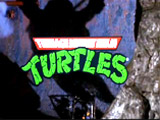
|
Teenage Mutant Ninja Turtles: The Movie (1990) This was the first of a trio of films (1990-1993). Jim Henson's and director Steven Barron's live-action feature film featured sewer-dwelling, crime-fighting Turtle characters named after Renaissance artists. The 4 turtles were latex puppets, radio-controlled, with synchronized lips for dialogue:
Because of a mysterious radioactive substance called Ooze, the four NY turtles mutated into giant green turtles, who could speak and walk ("heroes on a half-shell"). A wisdom-spouting rat named Splinter, a sensei-rodent, mentored them and taught them to become Ninja fighters, to combat the evil, power-hungry arch-enemy Shredder. Their main enemy was a mean Ninja gang known as the Foot. |

|
|||||||||||||||

|
Teenage Mutant Ninja Turtles II: The Secret of the Ooze (1991) A sequel directed by Michael Pressman, about the conflict between Shredder and the four turtles after their arch-enemy discovered where Ooze came from and used it to enhance himself. |

|
|||||||||||||||

|
Teenage Mutant Ninja Turtles III (1993) This was the third feature-length, live-action film in the franchise, directed by Stuart Gillard, and set in 17th century ancient Japan, in a time of the samurai. |

|
|||||||||||||||

|
Teenage Mutant Ninja Turtles (2003-2009) - TV series This animated FOX-TV series, the second animated TV series of TMNT, first aired on February 8, 2003, and ran for 7 seasons, ending on February 28, 2009, with a total of 155 half-hour episodes. The series marked the revival of the franchise as a Saturday-morning cartoon.
|
||||||||||||||||

|
Teenage Mutant Ninja Turtles (2007) This CGI-animated feature film was a sequel to the live-action film series (three films from 1990-1993) - it took place after the second film in 1991 and pretended the events of the third film never occurred. It was the first feature-length film in the franchise since 1993, 14 years earlier. In this installment, the four Turtles had grown apart after defeating the Shredder. Other ancient creatures now threatened NYC and the world. |

|
|||||||||||||||

|
Turtles Forever (2009) An 81-minute TV movie with the tagline: "Sometimes Four Ninja Turtles Just Aren't Enough." The completed film aired on the CW on Saturday morning, November 21, 2009, and was later released on DVD in 2010. It was the finale to the 2003 animated TV series (see above). It was produced in celebration of the 25th anniversary of the Teenage Mutant Ninja Turtles franchise, starting with Mirage Studios' May 1984 comic book issue. |

|
|||||||||||||||
Teenage Mutant Ninja Turtles (2012-present) - TV series This animated Nickelodeon-TV series was the third animated TV series of TMNT. It premiered on Nickelodeon on September 29, 2012. Currently in its third season, it has been renewed to continue.
|

|
||||||||||||||||
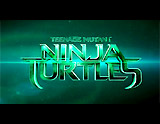
|
Teenage Mutant Ninja Turtles (2014) This film marked the beginning of a series of reboots (2014-2016), and also in 2023. It was a modern-day reboot directed by Jonathan Liebesman - a Michael Bay production, and a remake of the original 1990 live-action film. The four anthropomorphic mutant turtles were:
All of the Turtles were filmed in CGI (with motion-capture technology), while Megan Fox starred as live-action Turtles ally April O'Neil, a NYC TV news reporter. Fox received the Razzie Award for Worst Supporting Actress for her role. Although critically-lambasted, the film was financially successful. A sequel was planned for 2016. |

|
|||||||||||||||

|
Teenage Mutant Ninja Turtles: Out of the Shadows (2016) A sequel to the 2014 film. A 3D science fiction action comedy, again with Megan Fox as April O'Neil. The four voice actors and motion-capture performers were:
|

|
|||||||||||||||
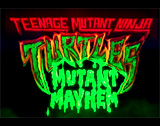
|
Teenage Mutant Ninja Turtles: Mutant Mayhem (2023) In this animated film, the four Turtles - Donatello, Michelangelo, Leonardo, and Raphael - hunted for a mysterious crime syndicate and faced an army of mutants. |

|
|||||||||||||||
V for Vendetta - was based on the comic book series by Alan Moore (illustrated by David Lloyd). The first episodes of V for Vendetta were originally published in black-and-white between 1982 and 1985, in Quality Comics' Warrior, a British comics anthology. They were then reprinted in color and continued by DC Comics in 10 issues of V For Vendetta # 1 - 10 (September 1988 to May 1989). The first issue of the ten issue DC Comics series to showcase original material that was not previously published in Warrior was in V For Vendetta # 8 (February 1989).
|
|||||||||||||||||
| Super-Hero Films | |||||||||||||||||

|
V for Vendetta (2006) Director James McTeigue's film was produced/scripted by the Wachowski Brothers. The story was set in the dystopian future in the UK. |

|
|||||||||||||||
Venom - the character of Venom was inspired by the comic book mini-series Venom: Lethal Protector (1993) (a 6-issue comic book series published by Marvel Comics from February 1993 to July 1993) and the story arc "Planet of the Symbiotes" (1995) (a 5-issue comic book series).
|
|||||||||||||||||
| Super-Hero Films | |||||||||||||||||
 |
Venom (2018) The character of Venom first appeared in director Sam Raimi's Spider-Man 3 (2007) as the title character's nemesis. Early on, there were efforts to create a spin-off film. Finally in 2018 after 11 years, the anti-hero origin story (or reboot) for Venom was released, directed by Ruben Fleischer. The central character was investigative journalist-reporter Eddie Brock (Tom Hardy), who had relocated from New York City to San Francisco. Venom (an alien creature or lifeform) was 'born' when Eddie was transformed into the super-human entity (and became its host) through symbiotic transference within a research facility in the city run by Life Foundation CEO Carlton Drake (Riz Ahmed). This film was not technically part of Marvel's Cinematic Universe. It was the 1st film in Sony's Spider-Man Universe (SSU). Besides the Venom films, Morbius (2022), Madame Web (2024), and Kraven the Hunter (2024) were also included in SSU. |

|
|||||||||||||||

|
Venom: Let There Be Carnage (2021) This was the 2nd Venom film in Sony's Spider-Man Universe. The character of Venom also made a brief cameo appearance in Spider-Man: No Way Home (2021). |

|
|||||||||||||||
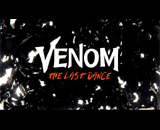
|
Venom: The Last Dance (2024) This was the 3rd and last Venom film in Sony's Spider-Man Universe. |
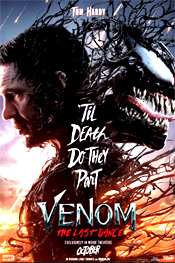
|
|||||||||||||||
Vision - was a superhero character who ultimately sided with the Avengers. He first appeared as an alien law-enforcement police officer (named Aarkus) in an alternate dimension known as Smokeworld in Marvel Mystery Comics # 13 (November, 1940) (published by Timely Comics). He was described on the cover as a "Sensational New Feature - The Vision." Next, he appeared as an android and a member of the Avengers that first appeared in The Avengers # 57 (October 1968). The third iteration was as the artificial intelligence known as J.A.R.V.I.S. (Just A Rather Very Intelligent System) that had become fused with the android's operating system. The natural-language user interface computer system, named after Edwin Jarvis (a butler for the Starks), was uploaded into the android's synthetic body made of Vibranium and, by merging with the power of an Infinity Stone, created an entirely new being known as Vision. |
|||||||||||||||||
|
|||||||||||||||||
| Super-Hero Films | |||||||||||||||||
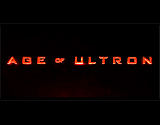 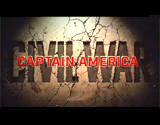 |
Avengers: Age of Ultron (2015) Paul Bettany played the role of Vision and J.A.R.V.I.S. in these two superhero films:
|
||||||||||||||||
Watchmen - was based upon the DC Comics monthly 12 issue comic-book mini-series Watchmen # 1-12 (September 1986 to October 1987, skipping June and September in 1987) by writer Alan Moore, artist Dave Gibbons, and colorist John Higgins. The British series was edgy, violent, and complex in its deconstruction of the superhero concept (and the end of costumed adverturing crimefighters). It reflected the tense historical period of the mid-1980s, with nuclear anxiety and a heated-up Cold War with Russia. This was the beginning of a new age in comic book publishing, known as the Dark Age of Comic Books (also known as the Modern Age). In the alternate universe of the Watchmen, superheroes were morally ambivalent, impotent, or psychotic. In one of the plots, one of the new Watchmen (Adrian Veidt/Ozymandias) had a plan to end the Cold War and save humanity from a US-USSR nuclear war - by uniting the world (and encouraging global cooperation) with the introduction of a major threat - a fake alien invasion of NYC that would - unfortunately, kill 3 million New Yorkers. The first issue was titled: "At Midnight, All the Agents..."
One of the main characters in the Watchmen universe was Dr. (or Doctor) Manhattan who made his first appearance in Watchmen # 1 (September 1986). Dr. Manhattan was originally a scientist (nuclear physicist) named Dr. Jon Osterman who in 1959 was accidentally obliterated or disintegrated by powerful atomic radiation in an Intrinsic Field Subtractor. He was transformed into a blue, naked, trans-human hyper-powerful being (without the need for air, sleep, food or water), who was able to teleport, use ESP, rearrange molecules, and engage in dimensional travel. He became affiliated as a crime-fighter with the US DOD's Crimebusters/Watchmen group. |
|||||||||||||||||
| Super-Hero Films | |||||||||||||||||

|
Watchmen (2009) Director Zack Snyder's and Warners' super-hero film presented a multi-generational history of many super-hero ("costumed adventurer") characters, within an alternate history in the year 1985, including:
|

|
|||||||||||||||
Woman in Red - was one of two female comic-book superheroes who claimed to be the first. [Note: The other was Fantomah - see earlier.] The Woman in Red, created by writer Richard Hughes and artist George Mandel for Nedor Comics, first appeared in Thrilling Comics # 2 (March 1940). [Note: the first Thrilling Comics issue featured the very first appearance of the comic book character - Dr. Strange.] The Woman in Red never appeared on the cover. She was called the Woman in Red because as a disguise, she wore a red, floor-length coat, hood, and mask.
Although she was not technically the first female superhero, the WIR was notable as the first "masked" and costumed super-heroine crime-fighter in the Golden Age of Comics, with a "natural" birth. Her alias was Police Detective Peggy Allen. She did not have any special powers, gadgets or training, but was an astute investigator, a marksman with a .45 automatic, and a great combatant. |
|||||||||||||||||
Wonder Man - was a short-lived superhero character (alter-ego inventor and radio engineer Fred Carson with a magic ring) created by Will Eisner. Wonder Man first (and solely) appeared in Fox Publications' Wonder Comics # 1 (May 1939). Because Wonder Man had identical powers to DC Comics' Superman, the competing company brought a lawsuit against Fox for copyright infringement to prevent future appearances, and Wonder Man was subsequently dropped.
|
|||||||||||||||||
Wonder Woman - the female superheroine was derived from the original DC Comics strip, first briefly appearing in All-Star Comics # 8 (December 1941-January 1942). She was created by William Moulton Marston, a famous psychologist (and the inventor of the lie-detector, and an early comic-book defender). In some ways, Wonder Woman was the female counterpart of Superman. Her origin story continued in Sensation Comics # 1 (January 1942) (with nine Wonder Woman appearances as the lead character). The first full-length comic devoted exclusively to her was Wonder Woman # 1 (June 1942). In her debut appearance on covers, she wore a golden tiara, a red bustier, blue underpants and knee-high, red leather boots. Wonder Woman combined the divine powers of six members of the Greek pantheon (Gods of Olympus), including Demeter, Athena, Artemis, Aphrodite, Hestia and Hermes. She was the daughter of Queen Hippolyta, born on Paradise Island (later called Themyscira) where immortal Amazons lived. Her real name was Diana of Themyscira, a Princess of the Amazons who lived free of men on the island. After growing up, where she had fallen in love with downed Air Force pilot Colonel Steve Trevor, a wounded intelligence officer, she left Paradise to fight fascism with feminism in "America, the last citadel of democracy, and of equal rights for women!" She traveled to Earth on a mission of diplomacy, justice and peace, and was affiliated with the Justice League and donning a patriotic costume (a star-spangled blue and white skirt). She had an armored red top, exposing her arms and shoulders. Her magical weapons included a Lasso of Truth, a pair of indestructible (bullet-proof) bracelets, a magical sword and a weaponized telepathic tiara. If her bracelets were melded together, she would lose her power.
In the late 1960s, beginning in Wonder Woman # 179 (December 1968), DC Comics attempted to update Wonder Woman by eliminating her costume and powers (she now wore skin-tight jumpsuits and functioned as a posh secret agent), and having her learn karate skills from a blind mentor, in the hopes that she would be accepted as a more realistic persona by the new 'women's lib' movement. She lost her title 'Wonder Woman' and retained her old name Diana Prince. On the cover of the issue, it exclaimed: "It's Goodbye to the Past for..." - and hello to the "New" Wonder Woman. Within only a few years, however, there was a backlash against eliminating Wonder Woman's traditional powers and her empowerment, in particular by critic Gloria Steinem. By the issue Wonder Woman # 204 (February 1973), she was given a second life. Diana's powers and costume were returned to her and she once again became the original Wonder Woman. One of the more recent changes in DC Comics regarding Wonder Woman came in August of 2010, in issue # 600, with a completely new look -- a blue jacket, a red-and-gold top, and darkish blue-black pants.
|
|||||||||||||||||
| Super-Hero Films | |||||||||||||||||


|
Wonder Woman (1974) The first attempt for a Wonder Woman TV series was a 75-minute TV pilot movie with blonde tennis star Cathy Lee Crosby as the lead character, although not wearing the comic book costume or the traditional tiara, and not possessing super-powers. ABC declined to pick up the pilot for a TV series after it aired on March 12, 1974 for the first time. |

|
|||||||||||||||
|
The New, Original Wonder Woman (1975-1979) - Pilot and TV series Another TV series - this one starred Lynda Carter (former Miss World USA) in satin tights as Wonder Woman/Diana Prince. She co-starred with Lyle Waggoner as Steve Trevor Sr. & Jr. It was more true to the comic book than the previous attempt, with Wonder Woman wearing her patriotic-themed, red, white and blue costume, and displaying both toughness and beauty. The successful pilot for the series, a 90-minute made-for-TV movie (running time 74 minutes), aired on ABC-TV on November 7, 1975, titled The New Original Wonder Woman. It was set in the style and period of the 1940s. It was followed by 59 episodes over three seasons, from 1976-1979. The first two episodes in Season 1 were two one-hour long specials. Three episodes in Season 1 featured Debra Winger as Diana's younger sister, Drusilla, aka Wonder Girl (Episodes # 4, 5, and 13).
|

|
||||||||||||||||
|
|||||||||||||||||

|
Wonder Woman (2009) - Animated Feature A 75-minute, direct-to-video animated film, directed by Lauren Montgomery. Princess Diana/Wonder Woman was voiced by Keri Russell. It was the first feature length animated film focusing on Diana of Themiscyra and the origin story of Wonder Woman. |

|
|||||||||||||||
 
|
Wonder Woman (2011) - TV Pilot Writer/producer David Kelley's un-aired, 43-minute live-action, Wonder Woman TV pilot starred Adrianne Palicki as Wonder Woman. The villain in the story was Veronica Cale (Elizabeth Hurley). A TV series was rejected by NBC for the 2011 season. The lead character was described as "a reinvention of the iconic DC Comic in which Wonder Woman - aka Diana Themyscira - is a vigilante crime fighter in L.A., but also a successful corporate executive and a modern woman." |
||||||||||||||||
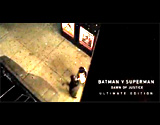
|
Batman v. Superman: Dawn of Justice (2016) In a small role, Gal Gadot portrayed Wonder Woman in this superhero film, marking the character's feature film live-action debut after 75 years of history. Gadot also starred in the lead role in the character's live-action films: Wonder Woman (2017) and the sequel Wonder Woman 1984 (2020). |
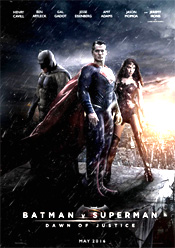
|
|||||||||||||||
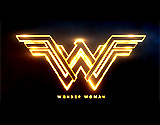
|
Wonder Woman (2017) Directed by Patty Jenkins, this was the first full-length feature film starring Wonder Woman. It followed the epic adventures and origin story of the former princess of the Amazons named Diana Prince, who became a super-warrioress (Gal Gadot), after being raised on a paradisical island (the Amazon island of Themyscira). During her training, she demanded that her warrior-aunt General Antiope (Robin Wright) train her, but at first, her mother Queen Hippolyta (Connie Nielsen) forbade it. She was instilled with the Amazons' responsibility to protect humanity against their enemy Ares, the Greek god of war, and bring peace by using her four special weapons: bracelets of victory, the lasso of truth, a battle shield/armor, and a magical 'god-killer' sword. During WWI (the Great War), Diana saved crash-landed US pilot-spy Capt. Steve Trevor (Chris Pine) in the sea - her first encounter with a man and future love interest. He was a British (Allied) spy being pursued by the Germans, who also invaded the Amazons' island but were defeated. Feeling dutiful to help those afflicted by the Great War in Europe, she was transported back to World War I-era London and the Western Front with Steve to save the world and stop the war. She targeted two evil individuals: German Army General Ludendorff (Danny Huston) (whom she erroneously believed was Ares) who had ordered 'mustard gas' to be developed and then used at the Western Front, and then villainous Sir Patrick Morgan serving in the Imperial War Cabinet in Britain, who was disguised and revealed to be Ares. This was the 4th film in the DC Extended Universe. |

|
|||||||||||||||

|
Wonder Woman 1984 (2020) Directed again by Patty Jenkins, this lengthy escapist sequel to the 2017 superhero comic-book film was set in the Reagan era of the 1980s. It opened with some backstory on the home island of Themyscira where young Diana (Lilly Aspell) competed athletically (in a very exciting and compelling opening sequence), and was taught truth and honesty from her aunt Antiope (Robin Wright) and mother Hippolyta (Connie Nielsen). Then fast-forward to 1984 in Washington, DC where Diana (Gail Gadot) was working as an archaeologist at the Smithsonian with the museum’s inept gemologist, Dr. Barbara Ann Minerva (Kristen Wiig), admiring and envious of Diana. One of the gems was a mysterious citrine crystal (with the magical power to grant wishes). Wonder Woman took on two new foes during the Cold War - The Cheetah (Barbara who was transformed into a fanged, furred, and clawed adversary by the gem), and con-man/oil-man tycoon/TV celebrity Marshall Lord (Pablo Pascal) who took possession of the gem. This was the 9th film in the DC Extended Universe. |

|
|||||||||||||||